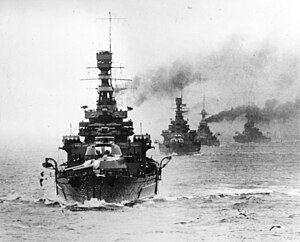Invergordon Mutiny

The Invergordon Mutiny , named after the Scottish port city of Invergordon , is a two-day mutiny by British seafarers on September 15 and 16, 1931.
causes
The Invergordon mutiny came about in the course of a labor dispute by around 1,000 British seamen of the so-called Atlantic Fleet of the Royal Navy .
Triggered the mutiny was the announcement of the new British government, due to the effects of the global economic crisis on the UK to cut all spending for the public sector by 10%. Of course, this measure also affected wages, which meant huge cuts for many workers.
In the course of parallel wage adjustments, this even meant a cut of almost 25% for all Royal Navy ranks below the petty officer . It affected all those who had entered service before 1925, as their wages were now automatically adjusted to the new, but already significantly lower, wage level that came into force in 1925. The fact that many sailors of the working class felt cheated by the policies of their Labor Party , since its chairman Ramsay MacDonald had formed a coalition with the hated Conservatives and formed the so-called national government alliance in order to create a grand coalition to better respond to Britain's economic crisis.
course
When the Atlantic Fleet entered Invergordon on September 11, 1931, the sailors learned of the cuts in their wages . Since a cut of 25% was announced in some newspapers, the displeasure of the sailors quickly increased, especially since the misunderstanding soon prevailed that all wages should be cut by 25%. On September 12th, in Invergordon, the written orders of the British Admiralty to cut wages were received, and on September 13th, copies of the orders were distributed on the ships of the Atlantic Fleet , in order to present them to the sailors, explaining the reasons for the drastic measures. However, not all ships received a copy, so that the measures were not fully explained to all crew members.
Due to the great dissatisfaction among the crew, there were more and more disputes with the officers in the days that followed , more and more refusals of orders and ultimately the stoppage of work on the part of the sailors. In its entirety, the mutiny was bloodless, largely non-violent, and there were only isolated fights against superiors .
The mutiny was finally settled on 16 September, as the Deputy Commander Rear Admiral Wilfred Tomkinson (the commander of the Atlantic Fleet , Admiral Sir Michael Hodges was in the hospital) assured the sailors that Rear Admiral Colvin had been sent as a negotiator for the Admiralty to the To discuss the cause of the mutiny through the sometimes excessive wage cuts. Since this would take a few days, he asked the sailors to return to normal duty that long. Towards the afternoon the Admiralty ordered by telegram that all ships of the Atlantic Fleet should leave immediately and return to their home ports . Seafarers whose wives were in Invergordon were given shore leave to say goodbye. During the night all ships then sailed properly.
consequences
In coming to terms with the mutiny in front of the Admiralty, Rear Admiral Tomkinson confirmed that the sailors had behaved appropriately and largely respectfully towards the officers. In his opinion, the cause of the mutiny was solely the drastic cut in wages. There was no apparent general dissatisfaction with the Royal Navy or the leadership. In addition, Tomkinson defended his decision not to put down the mutiny because he believed that violence would only have made the situation worse.
The Admiralty accepted Tomkinson's explanations, and it was decided to reintroduce the old, somewhat higher pay level before 1925 and then, like all wages from 1925, to reduce it by a flat rate of 10%. The Admiralty also stated that any further mutiny would henceforth be severely punished. No death sentences were passed on the mutineers in the wake of the Invergordon Mutiny , but some of the leaders were subsequently sentenced to prison terms. Other mutineers were dishonorably discharged or transferred from the Royal Navy.
The Admiralty subsequently found Tomkinson responsible for the mutiny and guilty of failing to nip it in the bud before it broke out.
To get rid of the stigma of mutiny, the British Admiralty renamed the Atlantic Fleet the Home Fleet again in 1932 .
literature
- Kenneth Edwards: The Mutiny at Invergordon . Putnam, London 1937.